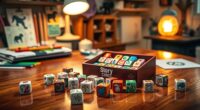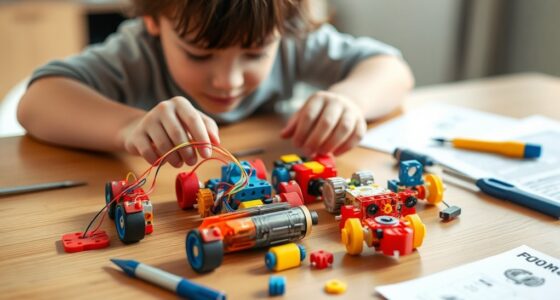You can turn everyday household items into fun, educational STEM toys by repurposing objects like plastic bottles, cardboard, and household electronics. Building simple machines, marble runs, or small robots from common items encourages creativity, critical thinking, and problem-solving. Not only are these projects cost-effective, but they also teach environmental responsibility and resilience. Keep exploring how you can creatively transform everyday objects into engaging learning tools — there’s much more to discover.
Key Takeaways
- Repurpose common household items like bottles, cardboard, and rubber bands to create engaging STEM learning toys.
- Design simple projects such as marble runs or pulley systems that promote engineering and physics concepts.
- Customize activities based on age and skill level to foster confidence and encourage iterative experimentation.
- Use everyday objects to teach environmental responsibility and stimulate creativity through resourceful building.
- Incorporate educational toys and hands-on methods to enhance understanding and make STEM learning fun and accessible.

Discovering how to create your own STEM projects at home is both exciting and rewarding. It opens up a world of possibilities to turn everyday household items into engaging learning toys that stimulate curiosity and critical thinking. One of the best approaches is to focus on using sustainable materials whenever possible. Instead of relying on store-bought supplies, look around your home for items like cardboard boxes, plastic bottles, rubber bands, or old batteries. These materials not only reduce waste but also provide a rich foundation for inventive projects. By repurposing items, you teach kids about environmental responsibility while fostering their creativity.
Repurpose household items like cardboard, bottles, and rubber bands to create eco-friendly, engaging STEM projects at home.
When you begin crafting your DIY STEM toys, you’ll discover that sustainable materials inspire creative problem solving. For example, you might challenge children to build a simple pulley system using a plastic bottle and some string, encouraging them to think about how forces work. Or, you could create a basic robot using recycled cardboard, motors from old toys, and leftover electronic parts. These activities push kids to analyze what materials work best, how to assemble different components, and how to troubleshoot when things don’t go as planned. This process strengthens their ability to think critically and approach problems from multiple angles.
Using household items for STEM projects also means you can customize the complexity based on age and skill level. For younger children, simple activities like stacking cups or making a marble run from toilet paper rolls can introduce foundational engineering concepts. For older kids, more advanced projects—such as designing a wind-powered vehicle from scrap materials—offer deeper insights into aerodynamics and energy transfer. The key is to keep the projects engaging and encourage experimentation. When kids see that they can create something functional or fun from items they’d otherwise throw away, it boosts their confidence and curiosity.
Another advantage of using household items is that it makes STEM learning accessible and cost-effective. You don’t need expensive kits or specialized tools; instead, you leverage what’s already available. This approach promotes independence and resourcefulness, qualities essential for problem solving. As you guide children through the process, emphasize the importance of trial and error, adjusting designs, and learning from mistakes. These lessons in resilience and adaptability are essential to developing a growth mindset, which is at the core of effective scientific thinking.
Additionally, incorporating educational toys that promote hands-on learning can complement DIY projects, reinforcing concepts and making the experience more engaging. In essence, creating DIY STEM toys from household items is about more than just fun; it’s a practical way to nurture innovative thinking, environmental awareness, and a love for learning. By focusing on sustainable materials and fostering creative problem solving, you’re empowering children to see everyday objects in a new light—transforming them into tools for discovery and education.
Frequently Asked Questions
What Safety Precautions Should I Take During DIY STEM Projects?
When doing DIY STEM projects, you should prioritize child safety by supervising kids closely and using age-appropriate materials. Always handle material hazards like sharp tools, hot glue, or chemicals with care, keeping them out of children’s reach. Wear protective gear such as gloves and goggles when necessary. Make certain a clean, organized workspace to prevent accidents. Following these precautions keeps everyone safe while you enjoy creating and learning together.
How Can I Customize Toys for Different Age Groups?
You might think customizing toys is just about colors and shapes, but don’t forget age-appropriate complexity and sensory-friendly designs. For younger kids, keep things simple and soft, avoiding small parts or sharp edges. For older children, add challenging puzzles or mechanical features. Always consider their developmental stage, ensuring safety and engagement. By tailoring the difficulty and sensory qualities, you create toys that truly grow with your child’s curiosity and skills.
Are There Recommended Materials for Sustainable DIY STEM Toys?
You should use recyclable materials and eco-friendly supplies for sustainable DIY STEM toys. These materials include cardboard, recycled plastics, and biodegradable items, which reduce environmental impact. By choosing these options, you create engaging toys that teach kids about sustainability while fostering creativity. Always prioritize non-toxic and safe supplies, ensuring your DIY projects remain fun, educational, and environmentally conscious for all age groups.
How Do I Assess the Educational Value of Homemade STEM Toys?
You can assess the educational value of your homemade STEM toys by observing learning outcomes and engagement metrics. Watch how well your child grasps concepts or solves problems with the toy, noting improvements over time. Pay attention to their enthusiasm and willingness to explore further. If they stay engaged and demonstrate understanding, your creation effectively promotes learning. Adjust based on these insights to maximize educational benefits and foster curiosity.
What Are Some Common Challenges Faced When Creating These Toys?
You might find that creating homemade STEM toys comes with challenges like fragility issues, where toys break easily, frustrating your efforts. Resource limitations can also hinder your progress, making it hard to gather all needed materials. Yet, these hurdles prove that ingenuity and adaptability are essential. Overcoming them shows your resilience and creativity, turning obstacles into opportunities to innovate and discover new ways to inspire learning at home.
Conclusion
By turning everyday household items into STEM toys, you not only save money but also discover endless learning opportunities. Sometimes, the simplest materials—like a paperclip or a plastic bottle—lead to the most inventive experiments. It’s funny how a common item can spark a child’s curiosity and passion for science, technology, engineering, and math. So next time you’re cleaning, remember: your trash might just become your child’s next great science project.










